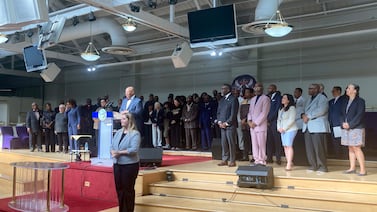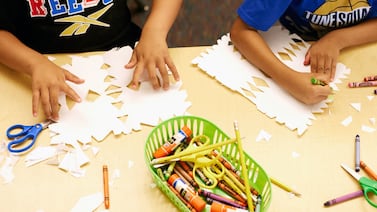A group of Denver students discussed a topic on a recent Friday that many of them had never studied before: the Haitian Revolution. The first discussion question: Should the Haitian Revolution, a successful rebellion of enslaved people that ended French colonial rule, be a part of history classes worldwide, just like the American and French revolutions?
All of the students said yes.
“The people who were fighting in the Haitian Revolution were fighting against their oppressive government,” said 16-year-old junior Kylynn White, unmuting herself on the video call where the class was taking place. “It’s some of the same things that are happening today.”
The vibrant class discussion provides a window into what is now a districtwide effort to add more Black, Hispanic, and Indigenous history to the curriculum. The changes, which could impact all 92,000 students in Denver Public Schools, were sparked by the advocacy of some of the same high school students who were discussing the Haitian Revolution that day.
“It’s beneficial that kids are able to learn this — that slaves were able to stick up for themselves,” said 16-year-old sophomore Dahni Austin.
Another student typed a comment in the chat box. “The people were great leaders and made change,” she wrote of the former enslaved people, such as Toussaint Louverture, who led the rebellion and became military generals. “And it also might empower students.”
That is the reason students most often cite when talking about why diversifying the curriculum is important. This most recent push came after a group of students from Dr. Martin Luther King, Jr. Early College visited the national African American history museum in Washington, D.C., last year. Immediately upon their return, they began speaking up about what they’d seen and questioning why they hadn’t been taught more Black history in school.
In response, their teachers visited the museum and pledged to revise their curriculum. Last month, the school board directed the entire district to do the same.
Brendan Kelly is one of the teachers who visited the National Museum of African American History and Culture at the students’ request. Kelly, who is white, said he was motivated by his Black students saying they felt their history was being left out — and when it was taught, that the lessons focused too much on oppression and struggle.
“That’s a tough thing to hear,” Kelly said. “I’ve always had the desire to do culturally responsive teaching, but it was about having to look in the mirror and be like, ‘I can do better.’”
This fall, Kelly began his history classes — both general world history and a course specifically on African American history — with lessons on ancient African kingdoms. The students learned about Mansa Musa of Mali, considered to have been one of the wealthiest people of all time.
White, who is taking Kelly’s African American history class, said the lesson resonated with her. Though she doesn’t know which part of Africa her ancestors are from, she said she felt like she was learning her own history — and unlearning it. Based on what she saw on TV, White said she’d always assumed the people of ancient Africa were poor.
“That’s not true at all,” she said. “That’s not my history. That’s not the African history.”
In world history, Denver students typically learn about colonialism and imperialism. To his course, Kelly added lessons on resistance and rebellion. He’s teaching about the Women’s War of Nigeria, a 1929 anti-colonial revolt led by rural Nigerian women, and the Battle of Adwa, in which Ethiopian forces defeated Italian invaders in 1896.
His African American history course takes a similar approach to the topic of slavery, with units on activist Frederick Douglass and rebellion leader Nat Turner. That course goes up through the modern Black Lives Matter movement and asks students to examine the experience of racism in America through the lyrics of hip-hop artists Lauryn Hill and Kendrick Lamar.
Austin, who is also taking the course, said the perspective from which slavery is taught is important for Black students.
“They will know their ancestors — some of them stood up for themselves and they were able to fight back for their rights and what they believed in,” she said. “In regular classes, you learn that slaves just followed what their owners say.”
Teachers at Dr. Martin Luther King, Jr. Early College, a middle and high school, have more leeway with the curriculum than do traditional district-run schools due to the school’s innovation status. But Kelly said he’d encourage all teachers to put aside the textbook and not limit the material they put in front of students to that written only by “old white men.”
Denver Public Schools also is revising its curriculum. The district has already sought an external review of its eighth grade U.S. history curriculum, and is aiming to review its 11th grade civics and economics courses by the spring. District leaders are in the midst selecting “a culturally representative, current, and relevant” elementary school social studies curriculum and ensuring school libraries are stocked with representative fiction and non-fiction books.
The district has also promised more training for teachers. “We will ensure that teachers are capable of delivering lessons that focus on Black, Indigenous, and Latino communities’ trauma with sensitivity,” says a resolution passed by the school board last month.
Jenelle Nangah is a 17-year-old senior who visited the museum in Washington, D.C., and is among the students who advocated for change. What she learned both at the museum and in her history class this year — about Toussaint Louverture, the Haitian Revolution, and all people who fought back against oppression — has given her a new perspective, she said. It’s an experience she hopes all Denver students of color are able to have.
“If what I learned did what it did for me, then all the kids that are able to be reached in a school environment, it’s going to make a really big impact,” Nangah said.







